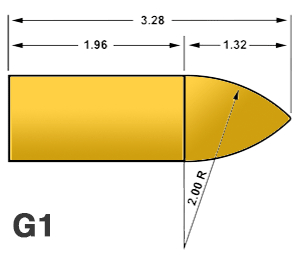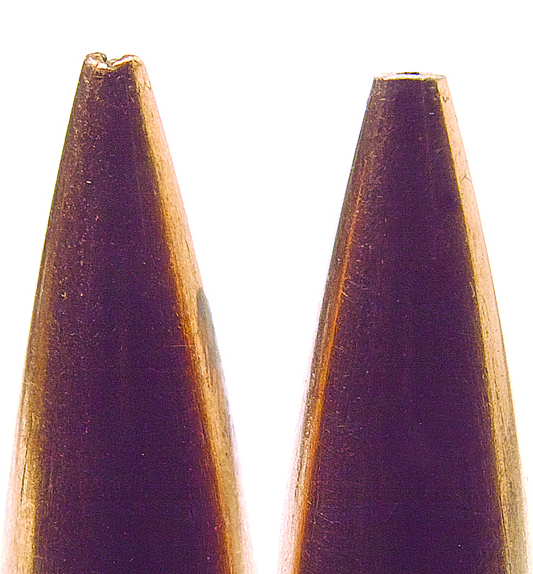Math and myth both get involved in bullet Ballistic Coefficient discussions. Keep reading to separate the two and learn exactly what BC is, and what it isn’t. MORE
Glen Zediker
Years ago I explained in great detail to a fellow here all about ballistic coefficient and how it was calculated and how it could be used and how it can change and so on, and he stopped me: “So you mean it’ll hit furtherer on up the hill…” That’s it.
A “ballistic coefficient,” or “BC,” is a number assigned to a bullet that suggests its aerodynamic performance.
That’s a key word, “suggests.” The main suggestion is how well this bullet will fly compared to that bullet, and the one with the higher BC ought to fly better. Fly better means less drop and drift, and those, factually, are a product of the higher-number BC. My best all-inclusive definition what a higher BC does for us: less speed lost over distance. Regardless of the muzzle velocity or the distance, one bullet with a higher BC will lose relatively less velocity over the same distance.

BC is calculated based on a standard bullet model. There are 7 of those. Two are normally used to determine BC for conventional rifle bullets, like what the most of us reading this use. Ballisticians and designers know which model to apply to different bullet types. The common model is a “G1” (another is G7, which is becoming the popular standard for boat-tail bullets; G1 is based on a flat-base). The flight of this G1 bullet has been calculated at varying velocities and distances. It’s “all math” because a G1 does not in fact exist. BCs are derived by comparison.

The standard bullet of any form-factor has a BC of 1.000. An actual bullet that’s compared to the model at points downrange will either be flying faster or slower than the model. If it’s moving faster, its BC will be greater than 1.000. If it’s going slower, it will be less than 1.000. It’s a percentage of the standard or model bullet’s performance.
Now. That is also all that it is!
BC is not an infallible factual statement about precisely what a bullet will be doing when it’s loaded and fired at that target than moment with that rifle. Not nearly, not hardly.
To me, BC gives us a place to start estimating drop (elevation) and also clues to how much it will get moved by a wind. It’s a way to compare bullets.
BC changes! Day to day, place to place, hour to hour.
Some bullet makers publish a BC for a bullet based on actual testing (chronographs) but now it’s pretty much “just math.” That’s fine. Which — math or measure — provides the best information? Some believe that a measured, tested BC is more realistic and, therefore, more valuable. But, if the point is to compare bullets, calculated BCs is more reliably accurate.
We (NRA High Power Rifle shooters) have gone to difficult and frustrating lengths to collect data to calculate “real” BCs (chronographing at 500+ yards hain’t always easy). Measured BCs are quite often lower, and they are quite often higher. Reasons follow.
The accuracy of drift and drop tables clearly revolves around what the actual, at that moment, BC performance is from the bullet you’re shooting (compared to what it’s “supposed” to be).
Anything that can influence bullet flight influences the actual, demonstrated BC performance.

Atmospherics, which add up as a list of factors, have a huge influence on BC performance. Air density is probably the most powerful influence. Any conditions that allow for easier passage of a bullet through the air don’t detract as much from its stated BC as do any conditions that serve to disrupt its headway. BCs are based on sea-level so can easily show as a higher number at a higher elevation. I can tell you that bullets fired at The Whittington Center in New Mexico have a noticeably better BC than those shot at Port Clinton, Ohio.
Range reality is that the demonstrated BC changes from morning to afternoon and day to day and place to place. The calculated BC is not changing, of course, but the mistake is assuming that a BC is a finite measure of bullet performance.
Bullet stability is even a factor. For a stated BC to be shown on a shot, the bullet has to be “asleep.” If it’s not stable, it’s encountering disruptions that will slow it down. The rotational speed of a bullet in a test can influence BC. We’ve seen differences comparing different twist-rate barrels, and the faster twists often show a little lower tested BC.
Factors that don’t matter in BC? Caliber. I’ve been argued at often over this next, but it is perfectly and absolutely true: BCs work the same regardless of caliber or bullet weight. Two bullets that each have a 0.550 BC, for instance, behave the same. That’s helpful, and at one time was more helpful than it is now. When we had to use paper tables to get drift and drop data and there was a new bullet that didn’t yet have those tables done, all you had to do was find data for another bullet with the same BC, go to the same muzzle velocity, and that data was 100-percent accurate. A .308 and .224 that both have the same BC share the same table. Remember, it’s not “real,” it’s a mathematical model.
So if you take a load to the target one day and you’re putting on more elevation than the BC-based calculation says you should, the BC isn’t wrong. The day is just different.
Finally, does it matter (really) if a bullet BC is based on a G1 or G7 model? Debates continue. But, not really, and I say that because BC is still only a suggestion. G7 is a more closely matched model to what we’re usually shooting when we think of a “high-BC” bullet, but all the same factors day to day also influence its accuracy. Given access to the data, I definitely, though, go with G7 calculations to have a place to start from. My experience has been that there is less difference in varying conditions, but, again, it’s still (plenty) enough change that you cannot dial it in and win anything…
The preceding is a specially-adapted excerpt from Glen’s book Handloading For Competition. Available HERE at Midsouth Shooters Supply. Visit ZedikerPublishing.com for more information on the book itself, and also free article downloads.










